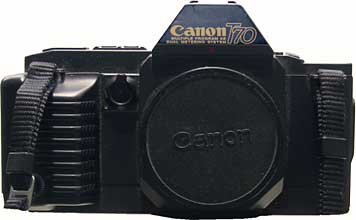
Lens Mount: FD bayonet/breech
Approx. dates of manufacture: 1984-1987
Approx. original price: $259.95
Approx. street value: Low-moderate
In the mid-80s Canon ended its A-series and began the T-series, the last of the manual focus cameras. All black, with a lot of plastic and composite materials, they were smaller, lighter, and far more electronically controlled than their predecessors.
There were several T-series cameras. Roughly: the T50 was an entry-level, nearly point-n-shoot camera; the T60 offered a few more features but not much; the T70 was the mid-tier camera that replaced the AE-1/AE-1 Program; the T80 which was a failed attempt at autofocus; and the top-of-the-line, super-deluxe T90 (which is still an expensive camera even though it has been out of production since 1991).
The T70 is just too cool for school. First off it has the built-in winder. For those of us who had the old cameras that had to be manually cranked, or were fitted with heavy winders and motor drives, a built-in autowinder is wonderful. Forget the utility, because they really do come in handy sometimes, they're just plain fun (though this came to bite me later when I was using an older camera and kept forgetting to manually advance the film). The T70 also ran on regular AA batteries that you could get anywhere, even out of a tv remote if you had to, whereas previous cameras used special, harder to find batteries (you can't get the proper battery for an original F-1, for instance. You have to make compromises).
.jpg) It took all the great Canon FD lenses and the A-series flashes, plus it took the T-series flashes, which were smarter, and a Command Back, which was
like the old Data Back—you can flash the date on it, or you can use an interval timer. But unlike the earlier Data Backs, with the Command Back you
could program it electronically. The Data Backs were mechanical which killed you when the years expired. I think mine topped out in 1996.
It took all the great Canon FD lenses and the A-series flashes, plus it took the T-series flashes, which were smarter, and a Command Back, which was
like the old Data Back—you can flash the date on it, or you can use an interval timer. But unlike the earlier Data Backs, with the Command Back you
could program it electronically. The Data Backs were mechanical which killed you when the years expired. I think mine topped out in 1996.
The real advance was in the electronic stuff. The T70 made the A-1 look brain-dead. It's got full manual, shutter priority (but not aperture priority) and three different kinds of program modes. Plus it has both center-weighted averaging and spot.
The thing I don't like is that I don't find it intuitive. With most mechanical cameras, once you figure out a couple of them, you can figure out how to run most of the others. You may not be able to do the fancy stuff like mirror-lock up or stop-down metering or backlight compensation, but you can set the shutter, set the aperture, set the film speed, that sort of thing. I keep forgetting how to do this on my T70 because I simply don't use it much, and that little LCD screen is nice but not helpful. So I find myself looking at the instruction book to remember how to switch exposure modes, set film speed, etc. The only other old camera that required as much instruction-book time from me was my Russian Zenit EM. I recently ruined almost an entire roll of film because I didn't realize I was using spot metering instead of averaging.
Mine was from a thrift shop, and I got a deal because someone had left the batteries in it and they began to leak. Luckily the leakage was minor and easy to clean up, so I got an excellent camera out of it and a reminder: check your camera batteries!
For more information: Canon Camera Museum
One of Modern Photography magazine's Top Cameras
Camera manual: Orphan Cameras.com



